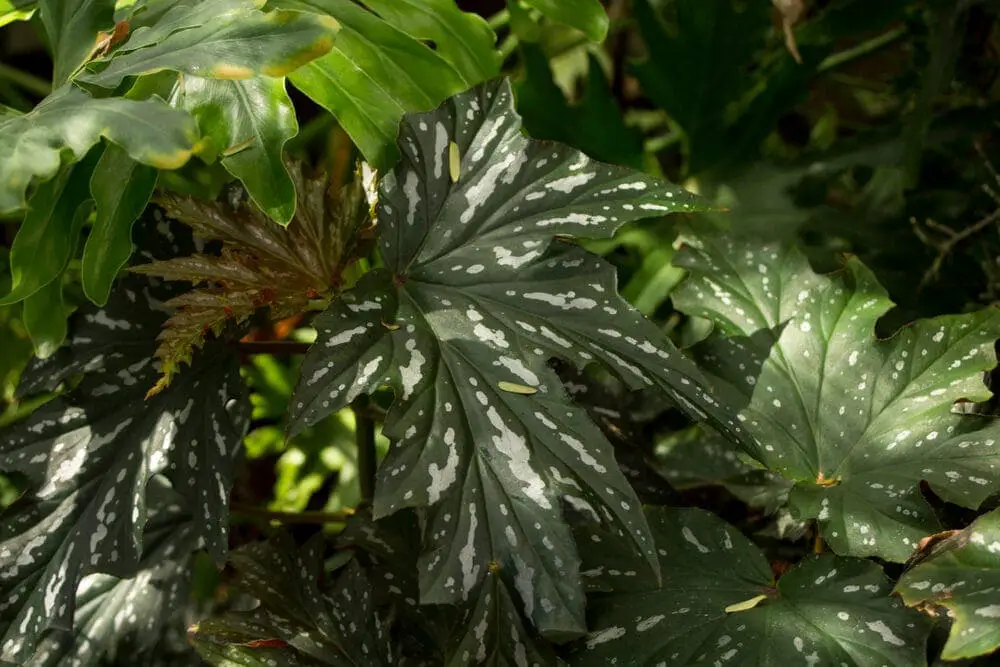The Angel Wing Begonia has some very unique leaves and isn’t very tricky to grow.
This plant gets its name from the shape of its leaves, and it makes for a great addition to any home’s landscaping. We will go in depth with how to grow and care for this plant in this article.
Angel Wing Begonia Care & Growing Guide
1. Light Requirement
This plant tends to thrive in bright, indirect sunlight throughout the entire year. While it isn’t as prone to damage as some other types of plants, it cannot withstand full direct sunlight. It is imperative that you keep this plant in a somewhat shady area.
You can put this plant in an area that receives direct sunlight for part of the day in the winter months. It is, however, never a good idea to give it too much direct light in the spring, summer or autumn seasons.
2. Water
During the summer you will need to water this plant on a daily basis to keep it healthy. It is crucial that you keep the soil moist without drenching it. Keep in mind that too much moisture in the soil can quickly result in root rot.
These plants don’t need to be watered as often in the winter months, but you don’t want the soil to dry up completely. The bottom layers of this plant’s soil should be somewhat moist, and the top layer should be fairly dry. These are good things to remember if you’re ever not sure about whether or not to water this plant.
3. Climate
One of the best things about this plant is how adaptable and versatile it is. It can be grown in subtropical, tropical, and Mediterranean climates. You can grow it in USDA hardiness zones of 10b and over.

4. Soil
You’ll want to make a point of using light soil that drains fast with maximum aeration for your Angel Wing Begonia plant. A regular all-purpose potting soil is perfectly acceptable. You should also add some peat moss and perlite or sharp sand. Compost is a must when it comes to helping this plant to thrive.
5. Temperature
The Angel Wing Begonia prefers a temperature range of 65 to 75 degrees Fahrenheit. It does not tolerate cold temperatures below 50 degrees Fahrenheit very well at all. In fact, even chilly weather can seriously damage its leaves.
If you are going to keep this plant in your home, you’ll be glad to know that you shouldn’t need to add any humidity. It is never a good idea to mist this plant, as it can cause mildew and even a fungal infection.
6. Repotting
While repotting is not necessary very often with these plants, you’ll want to use a smaller pot when you do so. This might seem like it doesn’t make all that much sense, but these plants actually like thrive this way. Make sure that you use fresh potting mix.
7. Speed of Growth
Angel Wing Begonias tend to grow fairly quickly when they are given bright but indirect sunlight as well as the right fertilizer.
8. Height and Spread
These plants can grow up to three feet tall and 12 inches wide. You should keep a distance of three to four feet between your plants to avoid complications with the roots.
9. Flowers
The beautiful and vibrant flowers that these plants produce are one of the things that make them so popular. The flowers can be any number of colors, including red, orange, pink, and white.
As the flowers begin to fade, you’ll want to take them off the stem. This will encourage the plant to produce new flowers that look great.
10. Trimming
Some pruning will be necessary to maintain the shape and attractive appearance of this plant. Take care to get rid of items that are grown out too far. Trimming will ensure a neatness that will make your plant look its best throughout the years. It also encourages fresh growth, which is important.

Is the Angel Wing Begonia Plant Poisonous?
These plants are considered to be very toxic and can produce a severe allergic reaction upon contact with the skin or when ingested. You need to be careful about keeping these plants in or around your home if there are pets or small children present.
How to get Angel Wing Begonia Plants to Flower
You can greatly increase the chances of getting your Angel Wing Begonia to bloom by providing it with lots of bright, indirect sunlight. You should also use a high-nitrogen fertilizer in the spring and summer months. This will encourage flower production in a big way.
Common Angel Wing Begonia Plant Diseases
Because these plants are prone to fungal infections, you’ll need to be careful about excess moisture. This means knowing when to water your plant, and never misting it at all.
Spider mites and aphids can also be a major problem with these plants. Keeping your plant in an environment with lots of humidity can help with preventing this issue altogether. There are also various pest deterrent products on the market you can try out.
Conclusion
- The Angel Wing Begonia needs bright, indirect sunlight to thrive and stay healthy.
- You can provide this plant with more direct sunlight in the daytime during the winter months when the sun isn’t as bright.
- Water this plant every single day in the summer and spring months, ensuring that the soil is kept moist but not drenched.
- You can reduce the frequency of your watering in the winter months, but you don’t want the soil to get too dry.
- Use soil that drains well with maximum aeration for the best growing results. You’ll also want to add some compost on the top layer of soil.
- These plants tend to do best within a temperature range of 65 to 75 degrees Fahrenheit.
- The flowers these plants produce are very colorful and look great.
- In order to get this plant to flower, you’ll need to provide it with ample sunlight on a daily basis, as well as a high-nitrogen fertilizer.
- Look out for pests like aphids and spider mites.

Victoria is the owner and main author of hobby plants. She loves spending her free time in her garden planting and taking care of her plants. Victoria hopes you enjoy the content here!